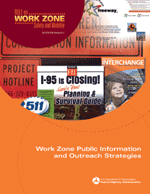U.S. Department of Transportation
Federal Highway Administration
1200 New Jersey Avenue, SE
Washington, DC 20590
202-366-4000
Focus
| Accelerating Infrastructure Innovations |
Publication Number: FHWA-HRT-07-013
Date: May 2007
To help State transportation agencies meet the challenge of maintaining work zone safety and mobility while performing needed rehabilitation and reconstruction work on the Nation's roads, the Federal Highway Administration (FHWA) has issued a collection of four guides:
Available online at www.ops.fhwa.dot.gov/wz/resources/final_rule.htm, the guides provide assistance in understanding and implementing FHWA's updated Work Zone Safety and Mobility Rule, which was published in the Federal Register in September 2004. The rule applies to all State and local governments that receive Federal-aid highway funding. Transportation agencies are required to comply with the provisions of the rule by October 12, 2007.
The overarching goal of the rule is to reduce crashes and congestion in and around work zones. Provisions in support of this goal encourage agencies to consider work zone safety and mobility impacts both early on and throughout the project delivery process and to expand work zone planning beyond the project work zone itself to address corridor, network, and regional issues. The updated rule also advocates expanding work zone management beyond traffic safety and control to encompass broader solutions that address the need for continued mobility during road construction.
Implementing the Rule on Work Zone Safety and Mobility includes a general overview of the rule, a look at differences between the updated rule and the former rule, sample approaches to implementation, examples of State transportation agency practices that relate to the rule's provisions, and sources for more information. Also featured are sections on developing and implementing a work zone policy, implementing agency-level processes and procedures, and developing and implementing transportation management plans (TMPs), which are required for all Federal-aid highway projects. Among the State examples highlighted is the California Department of Transportation's use of three categories of TMPs based on the expected work zone impacts of projects. The Ohio Department of Transportation, meanwhile, uses a work zone traffic management policy that includes a Permitted Lane Closure Map. The map provides a schedule of times when lanes can be closed on Interstates and other freeways.
Work Zone Public Information and Outreach Strategies addresses the use of public information and outreach as a work zone management tool. The guide includes sections on identifying the target audience, building partnerships, designing communications strategies, developing a campaign message, and working with the mass media. The guide also features examples of successful work zone public information and outreach campaigns used by transportation agencies. For example, in Santa Cruz, California, visually-impaired pedestrians were specifically targeted in the outreach campaign for a work zone that affected downtown sidewalks. And during the I-65 construction project in Kentucky, which involved full road closure on weekends, outreach was targeted to commercial truck drivers. This included publicizing project details and alternate routes in a direct mailing to trucking companies, in trucking industry publications, and on the CB radio network.
Guidance on evaluating work zone impacts is provided in Work Zone Impacts Assessment: An Approach to Assess and Manage Work Zone Safety and Mobility Impacts of Road Projects. "Many agencies already perform certain aspects of work zone impacts assessment. This guide reemphasizes them and puts them in the context of an overall approach for conducting comprehensive work zone impacts assessment and management," says Tracy Scriba of FHWA. "The approach presented in the guide incorporates additional concepts and principles advocated by the updated rule, such as in the areas of transportation operations, public information, and performance assessment." The assessment process follows the typical program delivery process of transportation agencies, including systems planning, preliminary engineering, design, and construction, as well as the ongoing activities of performance assessment, system management, and maintenance and operations.
The guide's appendices include a real-world example of how the work zone impacts assessment conducted by the Virginia Department of Transportation for its Woodrow Wilson Bridge project outside of Washington, DC, fits into the assessment process described in the guide. This assessment focused on the reconstruction of the I-495/Route 1 Interchange as part of the bridge project.
Developing and Implementing Transportation Management Plans for Work Zones looks at how coordinated transportation management strategies can be used to manage the work zone impacts of a road project. These strategies include temporary traffic control measures and devices; public information and outreach; and such operational strategies as travel demand management, signal retiming, and traffic incident management. The scope, content, and level of detail of a TMP can vary based on an agency's work zone policy and the anticipated work zone impacts of the project. A well-designed TMP can help agencies:
The guide includes sections on TMP development, implementation, and assessment; potential TMP components; transportation management strategies for work zones; and examples of current TMP use. Also included are appendices that contain a TMP components checklist and a work zone management strategies matrix.
In addition to the online versions of the guides, printed copies are available at no cost. To request a printed version, send an email to workzonepubs@dot.gov with the title of the publication, quantity needed, and shipping instructions. The guides will also be available on CD this summer. The CD will include such additional resources as an implementation checklist, frequently asked questions, work zone public information and outreach campaign framework templates, TMP components checklist, work zone management strategies matrix, and a flow chart illustrating how the rule applies to the project delivery process. The CD will also feature a brochure and four fact sheets on implementing the rule.
For more information, contact Tracy Scriba at FHWA, 202-366-0855 (email: tracy.scriba@fhwa.dot.gov), or visit www.ops.fhwa.dot.gov/wz/resources/final_rule.htm.
 |
 |
 |